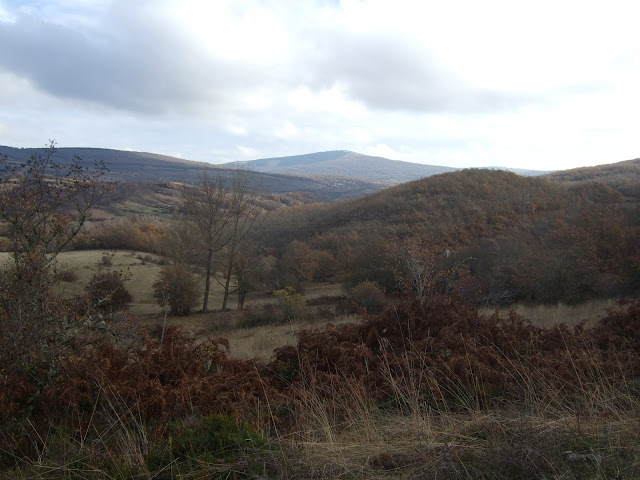Comenzamos este paseo circular en el pueblo de Valdeprado. Seguimos una pista que sale de la carretera bajando hacia el sur, y que pasa al lado de esta fuente.
We began this circular walk in Valdeprado, south Cantabria, taking a track that leads off the main road towards the south, and which takes you past this fountain.
Empieza a subir suavemente.
The track then goes very gently uphill
La pista gira hacia el oeste y entra en un robledal, que a finales de noviembre se ve un poco triste con las hojas mayormente muertas y caídas. Por suerte había momentos de sol, que alegraban el día.
The track bears right and goes into an oak wood, which at the end of November looked a little sad, what with the leaves having died or fallen to the ground for the most part. Luckily, there were moments of sunshine, which made things seem less gloomy.
Después de una hora llegamos a Moroso, un pueblo abandonado hace unas decadas, ya en ruinas. Aquí hay más información sobre los últimos años del pueblo.
After an hour's walk we came to Moroso, a village that was abandoned decades ago and now lies in ruins.
Está expuesto un poema muy sentido, que reproduzco aquí:
On display is this poem written by a former resident about his memories of the village
Después de leerlo, la visita al pueblo se hace más emotiva
Reading it imbues a walk round the village with greater empathy.
Proseguimos hasta el siguiente pueblo abandonado.
We then carried on to the next abandoned village
Nos indica la dirección a seguir uno de los postes tan trabajados que jalonan toda la ruta.
Helping us on our way, one of the beautifully made posts that dot the whole route.
En Candenosa parece que hay quien quiere rehabilitar una de las casas, pero no vimos a nadie.
In Candenosa one of the houses seems to be under reform, but we saw nobody.
Subimos al norte, al punto más alto de la ruta, donde cogemos la bifurcación a la izquierda. Unos cazadores y sus perros son los únicos seres vivos que encontramos.
We headed north, to the highest point of the walk, where we took the left turning. Some hunters and their dogs were the only sign of life we encountered.
Bajamos por una pista que atraviesa un hayedo. Hacia el suroeste se ve la provincia de Palencia.
We walked down a track through a beech wood. To the southwest lies Castile.
Llegando a Hormiguera. En este pueblo nos dieron una amable bienvenida dos perros que nos siguieron hasta el siguiente pueblo, evidentemente hambrientos de compañía.
Near Hormiguera. We were welcomed here by two dogs, who followed us all the way to the next village - obviously keen for company.
Y observándolo desde el este. Después de pasar al lado de la iglesia hay que bajar a la derecha por la carretera un poco hasta llegar a una pequeña curva, donde el camino balizado deja el asfalto para seguir a la derecha por los prados.
Looking back at Hormiguera. After going past the church you follow the road to the right down to a bend, where you take the signposted path on the right through the fields.
Pasamos por la aldea de Sotillo (3 perros, pero bastante menos amables), y tenemos buenas vistas del monte que hemos rodeado
We went through Sotillo (the 3 dogs here were not at all welcoming though), and continued past the woods we'd walked round during the previous 4 hours.
Delante tenemos San Vítores a la izquierda, y Valdeprado abajo a la derecha
In front of us lay San Vitores to the left, and Valdeprado down to the right.
Rápidamente llegamos a Valdeprado - habitado pero con ruinas
We were soon back in Valdeprado - inhabited, but with a fair number of ruins.









































































